当前位置:
X-MOL 学术
›
ACS Appl. Nano Mater.
›
论文详情
Our official English website, www.x-mol.net, welcomes your
feedback! (Note: you will need to create a separate account there.)
Piezoelectric Polarization Enhanced Photogenerated Carrier Separation of Bi2S3–BaTiO3 Nanostructure-Based Photoelectric Poly-L-lactic Acid Scaffold for Stimulating Cell Growth
ACS Applied Nano Materials ( IF 5.3 ) Pub Date : 2023-11-27 , DOI: 10.1021/acsanm.3c04178
Cijun Shuai 1, 2, 3 , Xiuwen Gao 1 , Yifeng Wang 4 , Hongyi Qian 4 , Wei Li 5 , Shuling Liu 6 , Huarui Zhou 7 , Shuping Peng 8, 9 , Fangwei Qi 2
ACS Applied Nano Materials ( IF 5.3 ) Pub Date : 2023-11-27 , DOI: 10.1021/acsanm.3c04178
Cijun Shuai 1, 2, 3 , Xiuwen Gao 1 , Yifeng Wang 4 , Hongyi Qian 4 , Wei Li 5 , Shuling Liu 6 , Huarui Zhou 7 , Shuping Peng 8, 9 , Fangwei Qi 2
Affiliation
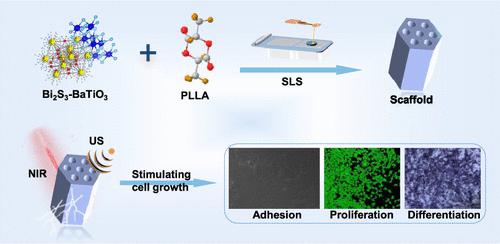
|
Bismuth sulfide (Bi2S3) could respond to near-infrared light to generate photocurrent, demonstrating tremendous potential in constructing self-powered electrical stimulation to accelerate bone regeneration. Nevertheless, the facile recombination of electron–hole pairs undermined its photoelectric performance. Herein, a sea-buckthorn-like nanostructured Bi2S3–BaTiO3 was synthesized by loading BaTiO3 nanoparticles onto Bi2S3 nanorods through a self-assembly method and then integrated into poly-L-lactic acid (PLLA) powders to fabricate PLLA/Bi2S3–BaTiO3 scaffolds. Piezoelectric BaTiO3 would deform under stress to produce instantaneous polarization, which triggered positive and negative charges presented on the relative surfaces of BaTiO3. Thus, the photogenerated electrons and holes of Bi2S3 would be, respectively, transferred to the positive and negative charged surfaces of BaTiO3, thereby achieving the electron–hole separation. Results revealed that under ultrasonic irradiation, the photoluminescence peak intensity of Bi2S3–BaTiO3 was significantly reduced compared with that of Bi2S3, confirming the improved electron–hole pair separation. Accordingly, the photocurrent of Bi2S3–BaTiO3 was increased by approximately 1.4 times in comparison with that of Bi2S3. The enhanced photocurrent effectively promoted cell proliferation and differentiation by upregulating alkaline phosphatase expression, enhancing calcium nodule deposition, and promoting cellular Ca2+ influx. Consequently, this work provided a perspective for establishing a self-powered electrical stimulated scaffold for bone repair.
中文翻译:

基于 Bi2S3-BaTiO3 纳米结构的光电聚 L-乳酸支架的压电极化增强光生载流子分离刺激细胞生长
硫化铋(Bi 2 S 3)可以响应近红外光产生光电流,在构建自供电电刺激以加速骨再生方面表现出巨大的潜力。然而,电子-空穴对的轻易复合削弱了其光电性能。本文通过自组装方法将BaTiO 3 纳米颗粒负载到Bi 2 S 3 纳米棒上,然后将其集成到聚L-乳酸(PLLA)粉末中,合成了沙棘状纳米结构Bi 2 S 3 –BaTiO 3制作PLLA/Bi 2 S 3 –BaTiO 3支架。压电BaTiO 3在应力作用下会发生变形,产生瞬时极化,从而引发BaTiO 3相对表面上出现的正负电荷。这样,Bi 2 S 3的光生电子和空穴将分别转移到BaTiO 3的带正电和负电的表面,从而实现电子-空穴分离。结果表明,在超声波照射下,Bi 2 S 3 –BaTiO 3的光致发光峰强度与Bi 2 S 3相比显着降低,证实了电子-空穴对分离的改善。因此,与Bi 2 S 3 相比,Bi 2 S 3 -BaTiO 3的光电流增加了大约1.4倍。增强的光电流通过上调碱性磷酸酶表达、增强钙结节沉积、促进细胞Ca 2+内流,有效促进细胞增殖和分化。因此,这项工作为建立用于骨修复的自供电电刺激支架提供了前景。
更新日期:2023-11-27
中文翻译:

基于 Bi2S3-BaTiO3 纳米结构的光电聚 L-乳酸支架的压电极化增强光生载流子分离刺激细胞生长
硫化铋(Bi 2 S 3)可以响应近红外光产生光电流,在构建自供电电刺激以加速骨再生方面表现出巨大的潜力。然而,电子-空穴对的轻易复合削弱了其光电性能。本文通过自组装方法将BaTiO 3 纳米颗粒负载到Bi 2 S 3 纳米棒上,然后将其集成到聚L-乳酸(PLLA)粉末中,合成了沙棘状纳米结构Bi 2 S 3 –BaTiO 3制作PLLA/Bi 2 S 3 –BaTiO 3支架。压电BaTiO 3在应力作用下会发生变形,产生瞬时极化,从而引发BaTiO 3相对表面上出现的正负电荷。这样,Bi 2 S 3的光生电子和空穴将分别转移到BaTiO 3的带正电和负电的表面,从而实现电子-空穴分离。结果表明,在超声波照射下,Bi 2 S 3 –BaTiO 3的光致发光峰强度与Bi 2 S 3相比显着降低,证实了电子-空穴对分离的改善。因此,与Bi 2 S 3 相比,Bi 2 S 3 -BaTiO 3的光电流增加了大约1.4倍。增强的光电流通过上调碱性磷酸酶表达、增强钙结节沉积、促进细胞Ca 2+内流,有效促进细胞增殖和分化。因此,这项工作为建立用于骨修复的自供电电刺激支架提供了前景。






















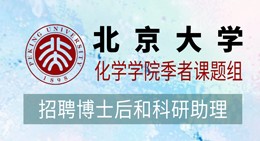
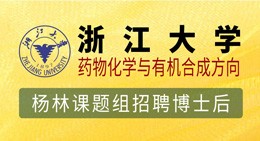

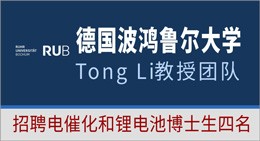
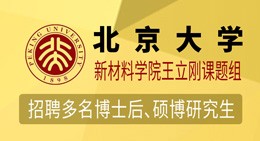






 京公网安备 11010802027423号
京公网安备 11010802027423号